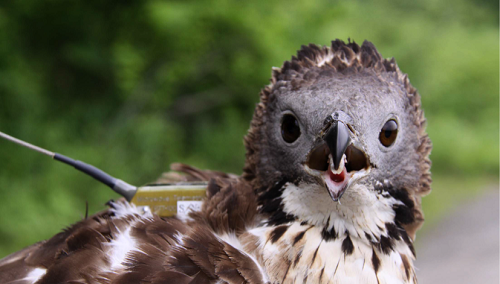← Back
Argos to study the migration of raptors in East Asia: Present state and future

Dr. Hiroyoshi Higuchi, Research and Education Center for Natural Sciences, Keio University, and his colleagues have satellite-tracked the migration of raptors for about 20 years. The species include Grey-faced Buzzards, Oriental Honey Buzzards, Common Buzzards and Rough-legged Buzzards. At the 2nd Argos Asian Wildlife Tracking Workshop, Dr. Higuchi will show the migration routes of these species based on Argos satellite-tracking.
Photo courtesy of Noriyuki Yamaguchi / Nagasaki
Insights into raptor migration
In addition to the general migration routes, the irruptive migration route of Rough-legged Buzzards to Japan will be shown, which was brought about as a consequence of unusually harsh weather conditions. He will also focus on the migration of Oriental Honey Buzzards, which were very successfully tracked for many years, and show their seasonal and yearly differences in the migration routes, important stopover sites, and site fidelity.
Impacts of climate change on raptor migration
His work reveals that many of the buzzards have the strict site fidelity to the breeding and wintering areas. His work also reveals the effect of climate change on migration routes. It is likely that wind conditions by mid-century will result in a reduction in the suitable areas for migration of the species over a critical section of its autumn migration and that its condition will be followed by a complete loss of this section of the traditional route by late century. Argos satellite-tracking is quite useful in studying such subjects by combining satellite images and computer simulation.
Dr. Hiroyoshi Higuchi

Dr. Hiroyoshi Higuchi
Dr. Hiroyoshi Higuchi is Professor Emeritus to the University of Tokyo and Visiting Professor at Keio University. He received a Ph.D. in the ecological and morphological studies of island birds from the University of Tokyo. He served as a visiting research scientist at the University of Michigan and as Professor of Biodiversity Science at the University of Tokyo. He is interested in various aspects of Avian Biology, ranging from the ecology and conservation of migratory birds through the conflicts between crows and humans to the effects of climate change on the life of birds and plants. He has published many books including “Ecology and Evolution of Birds” (Shisakusha, Tokyo), “The Journey of Birds–Satellite-tracking Bird Migration–” (SELC, Tokyo), “Birds, Humans, and Nature –Celebrating the Diversity of Life–” (University of Tokyo Press), and Natural History of Japanese Birds (Heibonsha, Tokyo).
